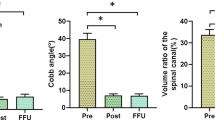Summary
Between January 1989 and July 1992, 76 patients with thoracolumbar fractures were operatively treated at the Department of Trauma Surgery, Hannover Medical School. After a mean of more than 3 years, 56 of 62 patients (90 %) still alive who had their implants removed were examined. According to the ASIF classification 33 patients sustained type A fractures, 13 type B and 10 type C. Three patients with incomplete paraplegia returned to normal; in one case of complete paraplegia no change occurred. In 40 cases the dorsal instrumentation was combined with transpedicular cancellous bone grafting. The mean operative time totaled 3 h. In this series, two complications (3.6 %) were observed: one iatrogenic vertebral arch fracture without consequences and one deep infection. Compared to the preoperative status, our follow-up examinations demonstrated permanent physical and social sequelae: the percentage of individuals able to do physical labor was reduced by half (22 to 11 patients) whereas the share of unemployed or retired patients doubled (4 to 8 patients). At the time of follow-up examination only 21 of 42 patients continued in sports. The assessment of complaints and functional outcome with the ”Hannover Spinal Trauma Score” reflected a significant difference (P < 0.001) between the status before injury (96.6/100 points) and at the time of follow-up (71.4/100 points).
The radiographic assessment in the lateral plane (Cobb technique) demonstrated a significant (P < 0.001) mean restoration from an initial angle of –15.6 ° (kyphosis) to + 0.4 ° (lordosis). Serial postoperative radiographic follow-up showed progressive loss of correction; at follow-up examination we found a mean of 10.1 ° (P < 0.001). Compared to the preoperative deformity a mean improvement of 6.1 ° to an average of –9.7 ° at follow-up examination was noted. The addition of transpedicular cancellous bone grafting did not decrease the loss of correction. CT scans after implant removal were performed in 9 cases: only 3 of 9 patients showed evidence of intervertebral fusion. No correlation could be found between ASIF classification and radiographic outcome. However, the preoperative wedge angle of the vertebral body correlated significantly with the postoperative loss of reduction. Due to disappointing results after dorsal stabilization with transpedicular cancellous bone grafting we recommend a combined procedure with dorsal stabilization and ventral fusion in cases of complete or incomplete burst injury of the vertebral body.
Zusammenfassung
Von Januar 1989 bis Juli 1992 wurden an der Unfallchirurgischen Klinik der Medizinischen Hochschule Hannover 76 Patienten mit Frakturen der thorakolumbalen Wirbelsäule operiert. Von 62 überlebenden Patienten nach Implantatentfernung konnten nach mehr als 3 Jahren 56 (90 %) nachuntersucht werden. Es handelte sich um 33 A-, 13 B- und 10 C-Verletzungen; 3mal lag ein inkomplettes Querschnittsyndrom vor, das sich vollständig zurückbildete; eine komplette Querschnittläsion besserte sich nicht. Neben einer Instrumentierung mit Fixateur interne wurde in 40 Fällen zusätzlich eine transpedikuläre interkorporelle Spondylodese durchgeführt. Die mittlere Operationszeit betrug 3 h. Es wurden 2 Komplikationen (3,6 %) beobachtet: Ein intraoperativer Wirbelbogenbruch ohne Konsequenz und ein revisionspflichtiger Infekt.
Die Spätergebnisse dokumentieren signifikante körperliche und soziale Dauerfolgen im Vergleich zum präoperativen Zustand: Während sich der Anteil der körperlich Arbeitenden halbierte (von 22 auf 11 Patienten), verdoppelte sich die Anzahl der Arbeitslosen und Berenteten (von 4 auf 8 Patienten). Sportliche Aktivitäten übten von ursprünglich 42 Patienten zum Zeitpunkt der Nachuntersuchung nur noch 21 aus. Der als Bewertungsmaßstab vorgestellte „Hannover-Wirbelsäulenscore“ zeigt im Vergleich zum präoperativen Zustand (96,9 von 100 Punkten) eine signifikant geringere Punktzahl (p < 0,001) bei der Nachuntersuchung als Ausdruck bleibender Beschwerden oder Funktionsbeeinträchtigungen (71,4 von 100 Punkten).
Röntgenologisch ließ sich mit dem Grund-Deckplatten-Winkel (GDW) eine durchschnittliche Korrektur der initialen Fehlstellung von –15,6 ° Kyphose auf + 0,4 ° Lordose nachweisen (p < 0,001). Bei jeder folgenden Untersuchung fand sich jedoch ein signifikanter Korrekturverlust, der zum Zeitpunkt der Nachuntersuchung im Mittel bei 10,1 ° lag (p < 0,001). Der absolute Wert betrug –9,7 ° und lag damit nur um 6,1 ° besser als der Ausgangsbefund. Einen positiven Effekt der transpedikulären Spongiosaplastik auf den Korrekturverlust konnten wir nicht nachweisen. CT-Untersuchungen nach Implantatentfernung zeigten lediglich bei 3 von 9 Patienten mit transpedikulärer Spongiosaplastik eine knöcherne Durchbauung.
Eine Korrelation zwischen dem Frakturtyp nach der AO-Klassifikation und dem radiologischen Spätergebnis konnte nicht nachgewiesen werden; es bestand jedoch ein statistisch signifikanter Zusammenhang zwischen der Schwere der Verletzung der vorderen Säule und dem postoperativen Korrekturverlust.
Wegen der enttäuschenden Ergebnisse nach transpedikulärer Spongiosaplastik und dorsaler Instrumentierung empfehlen wir bei Verletzung der vorderen Säule im Sinne eines inkompletten oder kompletten Berstungsbruchs ein kombiniertes dorsoventrales Vorgehen.
Similar content being viewed by others
Author information
Authors and Affiliations
Rights and permissions
About this article
Cite this article
Knop, C., Blauth, M., Bastian, L. et al. Fractures of the thoracolumbar spine Late results and consequences of dorsal instrumentation. Unfallchirurg 100, 630–639 (1997). https://doi.org/10.1007/s001130050168
Issue Date:
DOI: https://doi.org/10.1007/s001130050168




